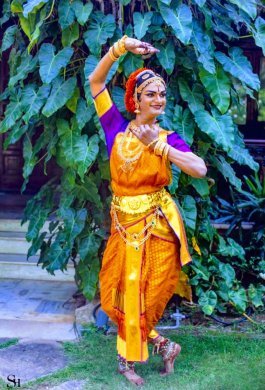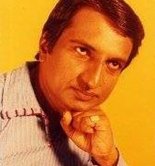
|   |

|   |
Nataraja Tejam - A tribute to Dr. Nataraja Ramakrishna - Vijay Shanker e-mail: vijaydance@gmail.com April 19, 2021 Dr. Nataraja Ramakrishna was an eminent mentor and exponent of Andhra Natyam and a musicologist. He hailed from Telangana but was born in Bali in 1923 to Damayanti Devi and Rammohan Rao. Due to his dancing skills he was bestowed with the title 'Nataraja.' He spent his boyhood days in Ramakrishna Math in Madras, hence interacted with great artistes like Meenakshi Sundaram Pillai, Vedantam Laxminarayana Sastry, Naidupeta Ramana (a dancer attached to Kalahasti temple) and Pendyala Satyabhama.  Dr. Nataraja Ramakrishna Nataraja Ramakrishna is particularly credited for his extensive research of Andhra Natyam and Perini Tandavam which was almost extinct but revived and refurbished by him. He published several books on dance in Telugu and English and is also credited for including Andhra Natyam in the syllabus of Potti Sreeramulu Telugu University. Silicon Andhra Music Performing Arts and Dance Academy (SAMPADA) in the United States with affiliation to Potti Sreeramulu Telugu University has introduced Andhra Natyam courses for students outside India. Since then students from US have enrolled and completed these courses. He was the chairman of Andhra Pradesh Sangeeta Nataka Akademi. He died on 7th June 2011 in Hyderabad at the age of 88. In order to celebrate the 98th birth anniversary of Dr. Nataraja Ramakrishna, whose in depth research on Andhra Natyam and Perini Siva Tandavam is acclaimed internationally, Nataraja Tejam was organised virtually for six days from 19th to 24th March. Incidentally 21st March marks his birthday. Disciples and leading dancers, guided by Guru Kalakrishna, ardent disciple of Dr. Nataraja Ramakrishna, came forward to celebrate and organize Nataraja Tejam.  Guru Kalakrishna & Sanjay Vadapalli On the first day, the inaugural was delivered by Guru Kalakrishna and the leading dancers who participated in the webinar were Sanjay Vadapalli, Satvika Penna, Muvva (Subha Rajeshwari), Sunila Gullapadi, guided by Kalakrishna and Dr. Suvarchala Suresh, who holds the distinction of being the first exponent to attain doctorate in Andhra Natyam from Potti Sreeramulu Telugu University, with the guidance of Dr. Nataraja Ramakrishna. On the second day, besides the performance by gurus and disciples, senior most vocalist Rama Jagannadh and Raghava Kumari (first disciple of Nataraja Ramakrishna) were felicitated. On the third day, Perini Siva Tandavam was performed by disciples of Perini gurus. Famous Perini dancer Perini Kumar and Perini singer Venkat Rao were felicitated. These events were organized by Vagdevi Arts Academy. On the fourth day, Nava Janardhana Parijatham was performed by Madhuri Surendra and organized by Swara Nartana Academy. The fifth day featured performances by US based disciples. Various students who learnt Andhra Natyam and Perini from Nataraja Ramakrishna, Kalakrishna and Perini Kumar have set up dance institutes in USA and are teaching dance to the next generation. The last day featured 'Jathi Jhari' pertaining to rhythmic jathis of Andhra Natyam. Andhra Natyam and Perini gurus were asked to write, compose and present a new jathi. Sanjay Vadapalli who is acclaimed as a leading exponent of Andhra Natyam, is presently seeking guidance from Guru Kalakrishna in the intense study and enactment of Nava Janardhana Parijatham. As a female impersonator, Sanjay dances with elegance and subtle expressions that creates a lasting impression.  Sanjay Vadapalli It is necessary to throw some light on Andhra Natyam and Perini Tandavam for the benefit of our readers. There are two ancient dance traditions in India, Natya Mela performed by men, and Nattuva Mela, which women perform. Andhra Natyam belongs to the Nattuva Mela tradition. Andhra Natyam, the ancient classical dance form of the Telugu regions (Telangana, Rayalaseema and Andhra), was almost extinct for the past 2000 years. It is as old as our ancient culture and the temples. It was performed in the Buddhist Aramas, temples, and royal courts by the cultured and dedicated female artists of Telugu regions. Andhra Natyam was formerly known with different names like Aradhana, Kacheri, Darbar, Kelika, Chinna Melam, Mejuvani, and Dasi Ata. Andhra Natyam was revived in 1970s and is being propagated for the last 50 years at national and international platforms, particularly in the Telugu speaking regions. Andhra Natyam includes beautiful, delicate body movements with graceful gestures and slenderness of the Kaisiki Vritti, performed by the female artistes and is a fine combination of Agama, Asthana, and Prabandha styles. It is performed in Marga tradition in temples as prescribed in Agama sastras. With a tinge of the Desi tradition, it is performed in the classical style in temple asthanas and courts of kings called Kacheri, Darbar ata, etc. The prabandha style is famous for its classical regional rendition with lokadharmi. It is an Eka Patra Kelika, i.e., a solo performance by a female artiste. It has been designed and is being depicted as one of the earliest female-oriented dance traditions, with a well-knit repertoire to suit the modern theatre. There is a specific repertoire of dance in it which is preserved through Guru shishya parampara. The lasya aspects of this female oriented dance form is unique and the grace and grandeur of the art is observed through the various dance pieces filled with grace and abhinaya filled with navarasas. The meter for the foot work, bendings of the body, body posture and hand movements are different and exquisite for Andhra Natyam, all of which make it a distinct classical dance form different from Kuchipudi and Bharatanatyam. The distinct feature of Andhra Natyam is the process that depicts the ancient tradition to suit the current stage. The repertoire contains the three traditions: Agama nartanam, Asthana nartanam, and Prabandha nartanam. In 1995, two festivals were held with Andhra Natyam performances at Vijayawada and Hyderabad to propagate the art form. In the same year, a G.O. was passed by the Andhra Pradesh State government to include Andhra Natyam as the syllabus for students at Telugu University and its affiliated colleges, enabling them to pursue Certificate and Diploma courses in Andhra Natyam. A 9-day festival was attended by some eminent artistes, historians, and scholars like Sharon Lowen, B.N. Sastry, Kala Subba Rao, and Gidugu Ramamurty unanimously agreed that Andhra Natyam needs to be propagated across India. Since then, hundreds of students have attained certificate and diploma certifications from Potti Sreeramulu Telugu University. In 2002, Andhra Natyam was introduced at the post-graduation level at Potti Sreeramulu Telugu University. Every year, a minimum of 5 students graduate from the University. Under Dr. Nataraja Ramakrishna's guidance, Dr. Suvarchala Devi holds the first Ph.D. in Andhra Natyam from Hyderabad. Perini flourished centuries ago in the Telugu speaking regions, reaching its peak during the Kakatiya rule. The dance finds mention in the early medieval work Bharataarnavam by Nandikeshwara. Based on this work, Dr. Nataraja Ramakrishna made the first mention of Perini in his award-winning book Daakshinaatyula Natyakala Charithra (1968). It is believed that Perini was presented for soldiers as inspiration (before the war) and entertainment (after the war). Dr. Nataraja Ramakrishna based his re-conceptualization on textual evidence from Bharataarnavam, Nritta Ratnavali, Sarangadeva's Sangeeta Ratnakara, and Sarvagna Bhoopala Yachendra's Sabharanjani. These works along with his vast knowledge of several classical dance forms helped him visualize Perini's movement techniques as did a study of sculptures in Telangana temples especially Ramappa temple. Valuable inputs came from his guru Nayudupeta Rajamma. His revival and reconstruction of Perini was the culmination of his decades long study of Telugu dance traditions, the dance texts and musical traditions pertaining to this part of the country, and study of (his pet topic) the intimate relation between music and dance. He emphasized that sounds of percussion instruments and 'sollukattu' (shushkaaksharaalu) generate a kind of vibration that in turn shapes the structure of movements of a dance.  Vijay Shankar is a Kuchipudi and Kathakali exponent, teacher, bilingual journalist, arts critic and actor. |